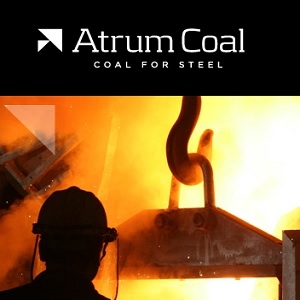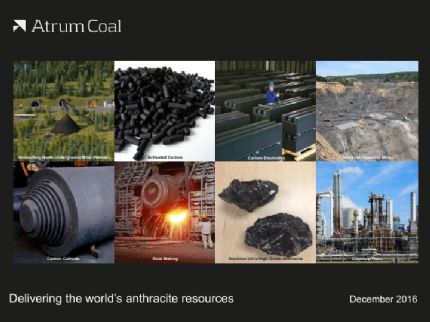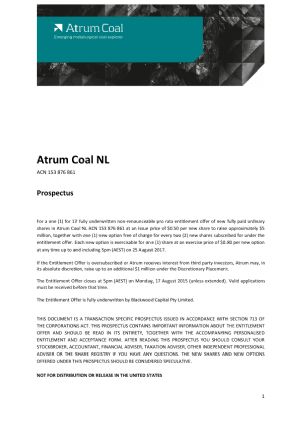
Update on Specialist Anthracite and Carbon Markets
Sydney, July 8, 2016 AEST (ABN Newswire) - Atrum Coal NL ("Atrum" or the "Company") ( ASX:ATU) (
ASX:ATU) ( ATRCF:OTCMKTS) is pleased to provide an update on marketing initiatives in relation to high margin specialty carbon markets, as the Company prepares for first production of anthracite from the Groundhog North Mining Complex ("Groundhog"), in British Columbia, Canada.
ATRCF:OTCMKTS) is pleased to provide an update on marketing initiatives in relation to high margin specialty carbon markets, as the Company prepares for first production of anthracite from the Groundhog North Mining Complex ("Groundhog"), in British Columbia, Canada.
HIGHLIGHTS
- Atrum enters into a non-binding Memorandum of Understanding in relation to sale of specialised carbon products.
- The Company continues to pursue a strategy of developing products suitable for use in high margin specialty carbon markets to further improve project economics
NON-BINDING MEMORANDUM OF UNDERSTANDING
Atrum has entered into a non-binding Memorandum of Understanding which sets out the principles for negotiating a Coal Sale and Purchase Agreement with a European manufacturer and supplier of specialised carbon products for the sale of anthracite product from Groundhog North as feedstock for the counterparty's manufacturing process (MoU).
The non-binding MoU is a key step in executing a diversified sales profile for Groundhog, and entering a growing market of highly valued specialised carbon products.
VP Marketing & Business Development, Mr Peter Doyle commented on the MoU:
"We are excited to be working with a supplier of high value carbon products. This MoU is an important milestone in our strategy of developing sales channels into growing, specialised carbon markets. The development of this MoU with our European counterpart is the second leg of our market entry plan, building from traditional steel markets for anthracite. Specialty carbon products by nature require ultra-high quality carbon inputs for the manufacturing process, and this feedstock is rare, and highly valued, which is typically reflected in higher pricing."
"Supply of European anthracite is diminishing, and imminent closures of major suppliers in western Europe is creating a strong demand profile from tier one economies, as the structural supply shortage of ultra-high grade anthracite continues. Groundhog is positioned to capture a significant portion of this growing market, and developing our sales channels early is a core pillar of our market entry strategy."
This MoU is a key component of the process to secure binding offtake and offtake marketing agreements. Atrum's market entry strategy centres on developing sales channels into growing specialty carbon markets, including briquettes, activated carbon, filtration media and producers of calcined anthracite for use in carbon cathodes and anodes, and synthetic graphite replacement for use in lithium-ion battery anodes.
The confidential counterparty to the MoU is a manufacturer of specialised high carbon briquettes and activated carbon, and a supplier of anthracite as filtration media. Atrum's market research indicates pricing in specialty carbon markets can command a premium to published bulk anthracite pricing. Our partner is well positioned to capture growth in western Europe, and Atrum is excited to be building strong commercial ties within this high priced, growth market.
Atrum is excited to enter this phase of our sales strategy, and to be working toward becoming the world's premier supplier of ultra-high grade anthracite.
HIGH VALUE / SPECIALTY ANTHRACITE MARKETS - AN UPDATE
The Company continues to pursue a strategy of developing products suitable for use in high margin specialty carbon markets to further improve project economics. These products are intended to supplement the primary high grade and ultra-high grade anthracite that is to be produced at Groundhog.
Research into specialty carbon markets indicates higher pricing may be available for specialty ultra-high grade anthracite from Groundhog, which would provide the opportunity for the Company to achieve higher margins than are currently being forecast in the Company's economic modelling.
The Company has investigated anthracite use as a filtration media, an activated carbon, for use in cathodes, anodes and electrodes, and as a synthetic graphite.
Filtration Media
The removal of suspended and colloidal particles by media filtration is based on their deposition on the surface of filter grains while water flows through a bed of these grains (filter media). The quality of the filtrate depends on the size, surface charge, and geometry of both suspended solids and filter media, as well as on water analysis and operational parameters.
Anthracite is one of the most common filtration media used in water treatment due to its inert characteristics. The effective grain size for anthracite filter is in the range of 0.7-0.8 mm making it an excellent use of Groundhog's anthracite 'fines' after washing.
According to a 2014 report "Global Media Based Water Filters Market Forecast and Opportunities 2019", the worldwide market for water filtration media is expected to exceed US$12b by 2018.
Anthracite filter media can be used in a range of applications:
Sewage Filters
- Mechanical Filters
- Revolving Screen
- Sludge Beds
- Secondary and Tertiary Filters
- Rapid and Slow Gravity Filters
Water Filters
- Rapid and Slow Gravity Filters
- Pressure Filters
- Swimming Pools
- Domestic Softeners
- Cold and Hot Softening Filters
General Usage
- Filtering Chemicals
- Acid Filters
- Alkali Waste Filters
- Industrial Waste
- Oil Removal
- Organic Waste
Depending on the specification, anthracite filtration media can trade at substantial premiums to market prices for lump and fine material. Due to its ultra-high grade, low impurities and very high fixed carbon content, Groundhog anthracite is expected to be able to be the feedstock of a quality filtration media.
Activated carbon
Activated Carbon is a porous material that removes organic compounds, pollutants, contaminants and other impurities from liquids, gases, chemicals, metals, etc, typically manufactured from coal, anthracite, nut shells or wood. Major markets include the US, North Asia, and Europe. Recent laws passed in the US have positively impacted market size there, and Atrum expects the activated carbon market in the USA will increase over the next five years due to the implementation of two laws: (1) the USA EPA Final Rule related to the removal of mercury from flue gases and (2) the USA EPA Disinfection By-Product Rule for potable water plants. Activated Carbon is also used in air filtration devices - filters, commercial air-conditioning units etc. According to recent research announced by Market/Markets in December 2015, the worldwide air filtration market is growing at 7.4% CAGR, and is forecast to grow from US$14.5b in 2015 to US$20.6B in 2020. Activated Carbon is also an excellent decolouriser that can remove dyes from aqueous and non-aqueous liquids.
Carbon Anodes
Carbon anodes are large carbon blocks which are used to conduct electricity during the aluminium reduction process (smelting). Typically made from graphite or anthracite, they are consumed during smelting at a rate of around 450 kg per 1000kg of aluminium produced. The two families of smelting technology in operation today - Soderberg and prebake - are characterised by the types of anode employed. The quality of anode impacts the technological, economic and environmental aspects of aluminium production. High grade and ultra-high grade anthracite can serve as the carbon source for both the Soderberg and prebake anode technologies. The anthracite is first calcined at temperatures above 2000°C in a gas or electric oven. This produces a very consistent carbon product suitable for the manufacture of anodes.
Soderberg smelters use a continuously created anode, made by the addition of pitch to the top of the electrolytic cell or "pot". The heat generated by the reduction process is used to bake the pitch into the carbon form required for reaction with alumina, thus recycling the waste energy in the pot.
Prebake technology utilises anodes which are baked in very large gas-fired ovens at high temperature before being lowered into the pot. These are then replaced once consumed. The efficiency of this technology compared to Soderberg, combined with its lower environmental impact, means that prebake smelters dominate the market with prebake systems in place in over 90% of worldwide aluminium production facilities. New facilities built today utilise this technology.
Global alumina production has almost doubled, from 61.9Mt in 2004 to 115.2Mt in 2015. However, China's alumina production has increased eight-fold from 7Mt in 2004 to 59Mt in 2015. The growth in aluminium production has led to an increase in carbon anode production. Currently, over 13Mt of anodes are produced per year for use in the aluminium sector.
Carbon cathodes
Carbon cathodes are made of anthracite, graphite and petroleum coke, which is calcined at around 1200°C and crushed and sieved prior to being used in cathode manufacturing. Carbon cathodes must have adequate strength, good electrical conductivity and high resistance to wear and sodium penetration. Graphitic carbon cathodes made from anthracite have higher wear resistance and slower creep than standard graphite and graphitized carbon cathodes.
According to Baiinfo Carbon Weekly, general market prices in 2014 were up to:
- US$1,120/t for 30% semi-graphitic carbon cathode
- US$1,230/t for 50% high-graphitic carbon cathode
- US$1,920/t for full-graphite carbon cathode
- US$2,720/t for full graphitization carbon cathode
Groundhog's ultra-high grade anthracite is expected to be sought after by cathode manufacturers to produce a quality graphitic carbon cathode, which although not achieving the pricing of full graphite or graphitized cathodes (that require more expensive carbon inputs such as graphite), should be able to be produced at a lower cost due to its high carbon content and bulk supply.
Carbon Electrodes
Carbon is used extensively in steel and metals manufacture, primarily as a reductant to remove oxides from metal ores or scrap metal. It is also used to improve the quality of the metal produced. Carbon electrodes are used in submerged arc furnace applications, to charge the molten metal (charge carbon), as an injection into the smelting process (injection carbon) and as a recarburizer.
Charge Carbon is a sacrificial carbon added to the Electric Arc Furnace (EAF) to consume excess oxygen in the melting process.
Injection Carbon (also known as Foaming Slag Carbon) is used to increase productivity, lower operating costs and increase the quality of the steel being produced. The carbon combines with oxygen in the molten slag and produces heat that causes the slag to bubble and foam. The resultant foamy slag improves electrical conductivity from the carbon electrodes to the molten metal, and reduces arc flare, increasing the efficiency of the electric arc process. Injection Carbon use is increasing in most EAF operations due to the efficiency and productivity gains available. Anthracite has traditionally been the carbon source of choice for Injection Carbon.
The recarburizer process adds carbon to molten steel to modify its qualities by ensuring a particular amount of carbon is added to the steel. Lower carbon steels typically use anthracite as a recarburizer, although petroleum coke and amorphous graphite is also used. Higher carbon steels require a very high carbon content recarburizer such as synthetic graphite although calcinced petroleum coke can be used when sulphur and gas content is not critical. In October 2014, Syrah Resources ( ASX:SYR) released a study on the recarburizer market and the potential for increased use of graphite in the 3.2mtpa market, noting, however, that graphite was unlikely to replace US$600/t anthracite in the recarburizer market.
ASX:SYR) released a study on the recarburizer market and the potential for increased use of graphite in the 3.2mtpa market, noting, however, that graphite was unlikely to replace US$600/t anthracite in the recarburizer market.
Finally, carbon electrodes used in these furnaces also require high carbon content sources. Manufacturers take a high grade carbon source, extrude rods that are then baked, machined and sold to electric arc and furnace operators. According to Baiinfo Carbon Weekly, general market prices in 2014 were as high as US$1,600/t for 1,000 - 1,100mm carbon electrodes.
Synthetic Graphite
High grade anthracite can be used to make synthetic graphite through high-temperature treatment (graphitization). Synthetic graphite is made to a variety of specifications that suit the specific needs of the end user. Most synthetic graphite is used in electrodes (including batteries), followed by the manufacture of carbon fibres then other uses such as blocks and powders.
It is the battery market that has captured the headlines over the last few years, as the electric vehicle market has grown. After a slow start, it appears that this market is going to exceed expectations. Bloomberg New Energy Finance estimates that electric vehicles will account for 35% of all motor vehicles by 2040, with predicted sales of 41m electric vehicles per year, 90 times the sales in 2015.
Lithium ion ("Li-ion") batteries utilise either synthetic graphite or spheroidal graphite (made from large flake graphite). Given the advancements in technology associated with the conversion of flake graphite into spherical or spheroidal graphite suitable for Li-ion batteries, there is some competition in the market between the two types of suppliers. Battery makers are increasingly making decisions on which type of carbon to use based on whether they are close to a synthetic graphite production plant or a spheroidal graphite production facility. Approximately 1.5Mt of synthetic graphite is produced per year but with a 90x increase in electric vehicles predicted, this could increase significantly.
Demand is set to grow almost exponentially in the USA, with the commissioning of Tesla's gigafactory which will use 100,000tpa of carbon in its Li-ion batteries by 202010, almost doubling the current demand in the Li-ion sector. The Company is investigating the use of anthracite fines as a feedstock for synthetic graphite in the USA as a carbon source to meet this demand.
To view figures, please visit:
http://abnnewswire.net/lnk/9S471P26
About Atrum Coal Limited
 Atrum Coal Limited (ASX:ATU) is a metallurgical coal developer. The Company flagship asset is the 100%-owned Elan Hard Coking Coal Project in southern Alberta, Canada. Elan hosts large-scale, shallow, thick, hard coking coal (HCC) deposits with a current JORC Resource Estimate of 298 Mt (70 Mt Indicated and 228 Mt Inferred). Comprehensive quality testing of Elan South coal on samples from the 2018 exploration program, combined with review of substantial historical testwork data for the broader Elan Project, has confirmed Tier 1 HCC quality.
Atrum Coal Limited (ASX:ATU) is a metallurgical coal developer. The Company flagship asset is the 100%-owned Elan Hard Coking Coal Project in southern Alberta, Canada. Elan hosts large-scale, shallow, thick, hard coking coal (HCC) deposits with a current JORC Resource Estimate of 298 Mt (70 Mt Indicated and 228 Mt Inferred). Comprehensive quality testing of Elan South coal on samples from the 2018 exploration program, combined with review of substantial historical testwork data for the broader Elan Project, has confirmed Tier 1 HCC quality.
The initial focus for development is the Elan South area, which is located approximately 13 km from an existing rail line with significant excess capacity, providing direct rail access to export terminals in Vancouver and Prince Rupert. Elan South shares its southern boundary with Riversdale Resources Grassy Mountain Project, which is in the final permitting stage for a 4.5 Mtpa open-cut HCC operation. Around 30km to the west, Teck Resources operates five mines (the Elk Valley complex) producing approximately 25 Mtpa of premium HCC for the seaborne market.
| ||
|






